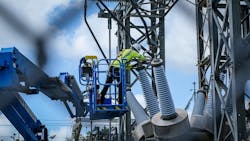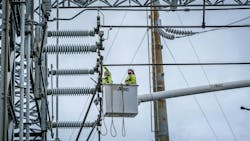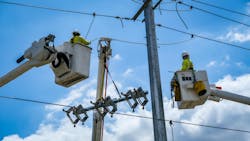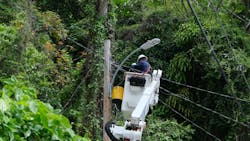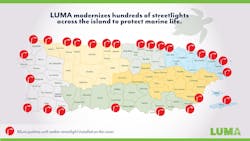With Puerto Rico’s climate zones and year-round growing season, overgrown vegetation is responsible for more than half of LUMA Energy’s outages to its 1.5 million customers on the island. The utility has cleared 3,900 miles of power lines since June 2021, and by the end of 2026, it expects to clear 16,000 miles of power lines — achieving a 35 to 45% reduction in outages.
To take a proactive approach to grid resiliency and reliability, LUMA is zoning in on vegetation clearance as part of its “Building a Better Energy Future” island-wide work plan. The federally-funded projects are mainly focusing on three key areas — vegetation clearing, automation devices and substation modernization.
“Nothing is more important for LUMA than continuing to improve reliability and the service that we provide to our customers. These combined initiatives, designed to build a better energy future, represent billions of dollars of investment into Puerto Rico’s electric system and are focused on improving overall reliability, as well as providing new ways to communicate and serve our customers in every municipality,” said Juan Saca, president and chief executive officer of LUMA.
Clearing Vegetation
LUMA recently launched its vegetation clearing initiative, a one-time, multi-year effort to clear overgrowth and vegetation across critical electric infrastructure. The plan will focus on a full remediation of all transmission and distribution rights of way (ROW), substations, and telecommunications sites. As part of its vegetation clearing initiative, LUMA is leveraging federal funding to clear transmission and distribution power lines and establish new ROWs on the island to improve service reliability. FEMA recognized that a vegetation reset is an eligible expense, and the work is also recognized under the Section 406 Hazard Mitigation Fund.
“Vegetation is a big part of our plan, and we are very excited we are beginning a historic project,” said Dr. Shay Bahramirad, senior vice president T&D, Strategy and Sustainability. “This one-time reset will allow us to improve the reliability significantly.”
LUMA has been partnering with the Central Office of Recovery, Recon-struction and Resilience (COR3), the governor of Puerto Rico and the Energy Bureau on the initiative. Each shares a collective commitment to executing the project, and together with the federal government, is making the necessary reviews, she said.
“This is a historic opportunity for Puerto Rico to not only improve the reliability and resiliency of the system but make it possible to rebuild the whole grid to provide enhanced levels of service,” Bahramirad said. “We are incredibly thankful to our local and federal government partners for their continued support in making this possible for the communities in Puerto Rico.”
During the first year of the plan in 2024, the vegetation clearing crews will clear 5,700 miles, and the second year in 2025, they will clear 6,900 miles. The third year, they will clear the remaining lines in the system.
“After the first year of the program, we are going to reduce the frequency of outages by 15 percent,” Bahramirad said. “This will have a significant impact on customer outages.”
Along with the sheer scope of the work, LUMA is also committed to comply with environmental laws and regulations related to vegetation, Bahramirad said. For example, the utility must comply with regulations set forth by the USDA, Forest Services, Puerto Rico Department of Natural and Environmental Services, U.S. Fish and Wildlife Services and others.
“Complying with environmental laws and regulation, protecting endangered species and environmental stewardship are LUMA priorities,” Bahramirad said.
In addition, many of the ROWs haven’t been touched or cleared per industry standards for many years, which creates additional obstacles for access. In addition, LUMA must take outages in certain cases to perform the work safely on the line.
“Because of the state of the grid and the extreme heat that everybody around the world is experiencing these days, it needs to be done very methodically,” she added. “These are a few of the challenges that we have to overcome, but we are committed to moving this project forward because of the significant implication to our customers.”
LUMA is focusing on creating improved access to the power lines to not only improve reliability, but also help to expedite the grid modernization projects.
“It’s going to help us to move forward with the construction and transformation of the grid faster because it takes less time to get to the structure, for instance, to change a pole on top of a mountain.”
Analyzing Data
During the vegetation clearing reset, LUMA is installing sensors and leveraging LiDAR technology to keep track of the progress, create a proper database and perform analytics moving forward. For example, LUMA’s team is taking LiDAR images of the ROWs to be able to establish the proper ROWs and understand the type and intensity of vegetation in different areas.
“We made a commitment to the federal government that we are going to ensure that moving forward after we cleared one time, we’re going to maintain it properly per industry standards,” Bahramirad said. The analytics and data gathering will help us to establish a condition-based system.”
An additional 1,300 to 1,500 new jobs will also be created to remove hazardous vegetation from across the island.
“This young, energetic talent is going to help us do vegetation clearance going forward, do proper analytics and make sure we keep it the way it has to be,” Bahramirad said.
Because Puerto Rico has various climate zones, it has different types of vegetation on the island, compounding the challenge of vegetation clearing. “The southern part of the island is drier compared to the middle, which has a mountainous area,” Bahramirad said. “This does create different challenges for the execution of the work as well as for the maintenance.”
By partnering with the University of Puerto Rico, LUMA is striving to understand the locality of plants and vegetation and learn how to use environmentally friendly treatment. “We are looking potentially into planting different types of vegetation under the ROWs,” she said. “For sure, it will not be a type of plan that creates an invasion, but it’s one of the scopes of collaboration with the University of Puerto Rico.”
Expediting Restoration
Beyond vegetation clearing, LUMA is also installing smart meters and grid automation devices. As part of the utility’s $876 million Meter Modernization Initiative, LUMA will install more than 1.5 million smart meters over the next three years. The smart meter technology will expedite response and service restoration through improved, remote outage detection technology.
To further help increase visibility into its transmission system, LUMA has installed sensors on different structures so when a fault occurs in the system, the field workforce can quickly identify its location.
“This type of data is going to help us to do the work analytically and more intelligently,” Bahramirad said. “We are trying to tackle improving the frequency and duration of outages from many different fronts, and one of the most important components is automation devices. They will help us to isolate the fault and impact a fewer number of customers so we can replace them faster and send our crews to the right place.”
In the past two years, the utility has installed 3,500 automation devices, and it plans to install 5,000 automation devices this year and next year. In five years, the utility plans to have 35,000 automation devices varying from three-phase reclosers to single-phase reclosers to cutouts and fault current indicators.
Another important benefit of this work is that it will help with integration of renewables and require less truck rollout, which means less carbon footprint. To determine where to install the devices, LUMA has been receiving technical assistance from six national labs and the Department of Energy.
“We look into different parameters such as the number of customers and historical reliability data,” Bahramirad said.
Modernizing Infrastructure
To increase the resiliency of its system, LUMA is also focusing on both modernization and the rebuild of infrastructure damaged by hurricanes. In addition, the utility is upgrading obsolete equipment past its life expectancy and providing operational flexibility and station redundancy.
“A proper planning hasn’t ever been done in Puerto Rico,” Bahramirad said. “We have been doing area planning and doing studies for both the transmission and distribution to identify the locations to eliminate the single point of failure.”
LUMA has seven new greenfield substations and is also replacing several high-voltage breakers and transformers to improve the resiliency of the system and reduce the likelihood of blackouts. For example, as part of its FEMA-funded Substation Modernization Initiative, the utility completed critical upgrades and improvements to the Sabana Llana substation in early December 2023, resulting in improved reliability across the island and optimizing distribution operations for customers served by other nearby substations.
At the Sabana Llana Substation, workers replaced breakers and an outdated transformer with industry-standard modern equipment. Crews also performed thermal imaging inspections and conducted necessary repairs at the substation and cleared vegetation. LUMA’s employees also protected crews and critical infrastructure by replacing 1200 ft of fencing and installing a secondary grounding area.
“The Sabana Llana substation is a critical part of achieving our goal to improve system reliability and help reduce the risk of future outages for our customers,” Saca said. “Work like this will help us achieve what we know the people of Puerto Rico expect and deserve — a more reliable energy service with fewer outages.”
LUMA is not only modernizing substations, but also upgrading its electrical system to improve reliability. Line workers have installed more than 10,400 poles as part of the utility’s commitment to build the overhead system to withstand 160 mph winds. LUMA plans to replace a significant number of the poles on the island in the next five years.
Due to the environmental conditions, some of the poles are constructed of concrete or fiberglass, while others will be made from steel. The line workers are also installing wider fiberglass crossarms, which aren’t as susceptible to corrosion due to saltwater exposure. The utility is keeping track of the assets in the system so as they move forward with modernization, it can do condition-based maintenance, ensuring that the assets have a longer lifespan.
Significant progress has been made in improving reliability, improving customer service and integrating more renewables than the past decade, but Bahramirad said there’s still a long way to go.
“We empathize with our customers that they have to experience outages, and we are working very hard to make sure that we design and modernize the grid, not only for the next two or three years, but for the next three generations of Puerto Rico,” she said.
Amy Fischbach ([email protected]) is the field editor for T&D World magazine.
Editor’s Note: The statistical data in this story are accurate as of press time. To listen to Dr. Shay Bahramirad talk about LUMA’s island-wide work plan, tune into the Line Life Podcast by going to linelife.podbean.com.
Building a Better Energy Future Work Plan
As part of LUMA’s Island-Wide Work Plan, the utility is planning projects to improve reliability and better serve its customers.
Reliability Improvement Initiatives
- Grid Automation
- Vegetation Clearing Initiative
- Substation Modernization and Rebuilds
- Pole Repairs and Replacements
- Advanced Metering Infrastructure (AMI)
Customer Service Initiatives
- Improved Outage Communications
- Financial Support and Flexible Billing
- Energy Savings Customer Programs
- Community Streetlight Initiative
Line Crews Install LED Streetlights to Save Energy and Protect Marine Life
As part of its Building a Better Energy Future island-wide work plan, LUMA is upgrading its electrical system. At the same time, it’s changing the way its communities are illuminated by installing new streetlights featuring LED technology. Through the FEMA-funded Community Street Lighting Initiative, LUMA’s line crews are installing streetlights that consume about 65% less energy and last up to four times longer than conventional sodium and mercury lights and have an added benefit of protecting the local marine life.
"We have installed streetlights that comply with all applicable laws and contribute to the conservation of endangered species,” said Heriberto González Méndez, director of LUMA's Community Street Lighting Initiative. “This initiative brings significant improvements to public safety and energy efficiency in communities across Puerto Rico."
To date, the utility has modernized hundreds of streetlights across the island, including those in sea turtle nesting areas. LUMA is coordinating with turtle conservation groups like 7 Quillas to ensure a safer environment for the reproduction and survival of the endangered species.
“Light pollution is very harmful to turtles because it confuses them and leads them away from the coast," said Karen Schneck Malaret, education coordinator for 7 Quillas.
See the map below to see where the new streetlights have been installed on the island.
About the Author
Amy Fischbach
Electric Utilities Operations
Amy Fischbach is the Field Editor for T&D World magazine and manages the Electric Utility Operations section. She is the host of the Line Life Podcast, which celebrates the grit, courage and inspirational teamwork of the line trade. She also works on the annual Lineworker Supplement and the Vegetation Management Supplement as well as the Lineman Life and Lineman's Rodeo News enewsletters. Amy also covers events such as the Trees & Utilities conference and the International Lineman's Rodeo. She is the past president of the ASBPE Educational Foundation and ASBPE and earned her bachelor's and master's degrees in journalism from Kansas State University. She can be reached at [email protected].
